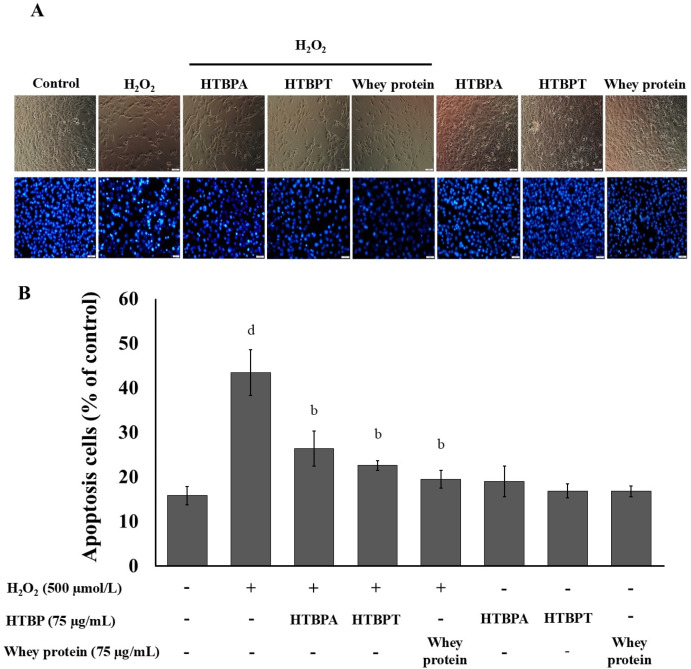

Highlight
This study developed hydrolyzed tuna blood powder (HTBP) from canned tuna industry by-products and demonstrated its antioxidant and anti-apoptotic effects on C2C12 muscle cells under oxidative stress. HTBPs, particularly those produced with alcalase and trypsin, reduced ROS and NO levels, suppressed apoptosis-related proteins, and improved cell survival. These findings suggest HTBP as a promising functional ingredient for muscle recovery and sustainable resource utilization.
ที่มาและความสำคัญ
ในปัจจุบัน ความสนใจด้านการออกกำลังกายและสุขภาพร่างกายที่ดีเพิ่มสูงขึ้นอย่างต่อเนื่อง ส่งผลให้มีความต้องการผลิตภัณฑ์อาหารฟังก์ชันและอาหารเสริมที่ช่วยฟื้นฟูกล้ามเนื้อและเพิ่มสมรรถภาพทางกายมากขึ้น โดยภาวะเมื่อยล้าของกล้ามเนื้อและการสูญเสียมวลกล้ามเนื้อมักเป็นปัญหาที่เกิดขึ้นจากการออกกำลังกายอย่างหนัก ซึ่งมีสาเหตุหลักจากการสลายตัวของโปรตีนในกล้ามเนื้อร่วมกับการสะสมของอนุมูลอิสระ (ROS) ภายในเซลล์กล้ามเนื้อ การผลิต ROS ในปริมาณมากส่งผลให้เกิดความเครียดออกซิเดชัน ซึ่งทำให้การทำงานของกล้ามเนื้อแย่ลงและเพิ่มความเสี่ยงต่อการบาดเจ็บของเนื้อเยื่อกล้ามเนื้อ ดังนั้น การพัฒนากลยุทธ์เพื่อลดความเครียดออกซิเดชันและเร่งกระบวนการฟื้นฟูกล้ามเนื้อจึงเป็นสิ่งสำคัญ โดยเฉพาะสำหรับนักกีฬา ผู้ที่ออกกำลังกายเป็นประจำ และผู้ที่ต้องการรักษามวลกล้ามเนื้อ
ปัจจุบันเลือดปลาทูน่าเป็นของเสียจากอุตสาหกรรมที่ยังไม่ได้ใช้ประโยชน์ ทั้งที่อุดมด้วยกรดอะมิโนและแร่ธาตุสำคัญ อีกทั้งยังมีรายงานว่าเปปไทด์จากน้ำต้มปลาทูน่าสามารถยับยั้งเอนไซม์ ACE และกระตุ้นการเกิด apoptosis ในเซลล์มะเร็งเต้านม อย่างไรก็ตาม ยังไม่มีการศึกษาอย่างชัดเจนเกี่ยวกับศักยภาพของไฮโดรไลเซตจากเลือดปลาทูน่าในการเป็นวัตถุดิบเชิงหน้าที่เพื่อการฟื้นฟูกล้ามเนื้อ งานวิจัยนี้จึงมุ่งพัฒนาไฮโดรไลเซตจากเลือดปลาทูน่าเพื่อใช้เป็นส่วนผสมในผลิตภัณฑ์เพื่อสุขภาพกล้ามเนื้อ พร้อมส่งเสริมการใช้ทรัพยากรอย่างคุ้มค่าและยั่งยืน
Abstract
This study aimed to develop hydrolyzed tuna blood powders (HTBP) with potential anti-apoptotic and muscle recovery properties. HTBP was produced alcalase, trypsin, and pepsin at concentrations of 0.5%, 1.0%, and 1.5%. The physical and chemical properties of HTBP were evaluated. The results showed no significant difference in yield (p > 0.05), with a range of 7.08% ± 0.78% to 9.26 % ± 1.74%. HTBP produced with alcalase at all concentrations yielded a higher amount of protein (76.86% ± 0.5%–79.1% ± 1.10%) compared to trypsin and pepsin. Glutamic acid, cysteine, and aspartic acid were identified as the main amino acids in HTBP. The water solubility index of all HTBP was high (>90%). Antioxidant values increased with higher protein content. Hydrolyzed tuna blood with 0.5% alcalase (HTBPA) and 0.5% trypsin were selected for further investigation of their biological activities, assessed using C2C12 muscle cells under oxidative stress conditions induced by hydrogen peroxide (H2O2). In H2O2-induced C2C12 cells, HTBPA and HTBPT reduced nitric oxide (NO) secretion and intracellular reactive oxygen species (ROS) levels. Furthermore, HTBPA and HTBPT significantly decreased the percentage of apoptotic cells in these H2O2-induced C2C12 cells. They also inhibited H2O2-induced apoptosis by modulating apoptosis-related proteins, including NF-κB, Bax, and caspase-3. Additionally, HTBPA and HTBPT suppressed the phosphorylation levels of key signaling proteins such as Akt, ERK1/2, and p38, thereby contributing to enhanced cell survival. These findings suggest that hydrolyzing tuna blood, waste of the canned tuna industry, can create a valuable ingredient for promoting muscle health.
KEYWORDS: Hydrolyzed tuna blood powder, Antioxidant activity, C2C12 cells, Apoptosis, Oxidative stress
Citation: Hawangjoo, M., Rungruang, P., Sroyraya, M., Chonpathompikunlert, P., Roytrakul, S., Sukketsiri, W., & Klaypradit, W. (2025). Physical and chemical properties and anti-apoptotic effects on C2C12 cells of hydrolyzed tuna (Katsuwonus pelamis) blood powder. Food Bioscience, 66, 106168. https://doi.org/10.1016/j.fbio.2025.106168
RELATED SDGs:
SDG Goal หลัก ที่เกี่ยวข้อง
12. RESPONSIBLE CONSUMPTION PRODUCTION

3. GOOD HEALTH AND WELL-BEING

ผู้ให้ข้อมูล: ผู้ช่วยศาสตราจารย์ ดร.มรกต สร้อยระย้า
ชื่ออาจารย์ที่ทำวิจัย: ผู้ช่วยศาสตราจารย์ ดร.มรกต สร้อยระย้า
Credit ภาพ: ผู้ช่วยศาสตราจารย์ ดร.มรกต สร้อยระย้า
Tags: Antioxidant activity, Apoptosis, C2C12 cells, Hydrolyzed tuna blood powder, oxidative stress
